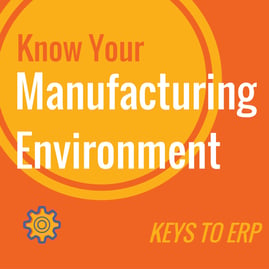How to Define Success in Your Manufacturing Environment
 Declaring the manufacturing environment for each product family sets the strategy for that family. It also identifies the proper set of tactics that must be paid attention to if you are to succeed.
Declaring the manufacturing environment for each product family sets the strategy for that family. It also identifies the proper set of tactics that must be paid attention to if you are to succeed.
There are four primary manufacturing environments. All four are defined by comparing the difference between customer lead-time (i.e., the amount of time a customer will wait for the product) and the cumulative manufacturing lead-time (i.e., the amount of time it takes to procure material and produce the product through all levels of assembly). It is the “intersection” of these times that determines the location of inventory and the schedule to replenish that inventory with respect to the bill of material. Let’s start with Make to Stock.
Make to Stock (MTS)
In the make to stock environment, customers are not willing to wait very long for products (with respect to your cumulative manufacturing lead-time). Because of this, production must be completed prior to the arrival of the customer order. Since production is completed prior to the order, each customer gets the same, standard product.
- In MTS environments forecasting requirements at the top level of the bill of material is extremely important.
- Capacity is usually performed as a “rough-cut”; just enough to make sure the schedule stays realistic.
Make to Order (MTO)
In the make to order environment, customers are willing to wait almost all of your total manufacturing lead-time. This is because they want a custom product, or a service performed on their product. Because of the customization in this environment, production is not started until the receipt of the customer order. This changes slightly when customers place blanket orders, as we will discuss shortly.
If there is any schedule at all in the MTO environment, it is near the bottom of the bill of material where common parts and assemblies are found.
- Customer orders drive almost the entire schedule and capacity is extremely important.
- Business vitality is measured by backlog.
- Finite capacity planning is often found here in the MTO world.
The MTO world sometimes emulates the MTS environment. When customers place “blanket orders” for specific quantities across time, producing the product becomes repetitive. When this happens, the repetitive nature of the blanket order makes it easy to confuse the MTO environment with that of MTS. In fact, target levels of finished product are typically set as a buffer and product is scheduled to replenish that target. The tactics become the same as managing a finished goods inventory in the MTS environment. The major difference is that blanket orders have end dates whereas parts in the MTS environment do not. The end date of the contract therefore must be managed carefully so that the system is not loaded with material at the end.
Another way to think about the blanket order or repetitive issue is to look at who owns the product. Many organizations in the MTO environment do not own the products they produce or service, but rather own a process. It would be a mistake to build ahead of a contract or purchase order assuming that another order will be issued. Unless you own the product and can sell it to someone else in that form, you should be careful about setting target inventories and building beyond current orders.
Assemble to Order (ATO)
The ATO environment is a hybrid between the make to stock and make to order environments. In the assemble to order environment, customers are willing to wait longer for your products then make to stock (with respect to your cumulative manufacturing lead-time), but still not as long as your cumulative lead-time. Because of this, some production must be completed prior to the arrival of the customer order, but not all of the production.
- Features and options characterize this environment.
- The number of configurations for finished goods makes it too risky to stock product at the finished goods level, thus sub-assemblies (i.e., options) are stocked and orders assembled after arrival.
- Between the finished good and option levels we find make to order. From the option level and down, we find make to stock.
Best practices show that the point of scheduling and inventory in this environment is typically at the sub-assembly or option level. Above that level, actual customer orders create the final assembly schedule. Below that point, typical MRP planning exists. Rough-cut capacity is typically tied to this “option” level as well.
Engineer to Order (ETO)
Engineer to order is the same as make to order, with the exception of the engineering time. In MTO, the engineering time is completed. In ETO, it is not and the customer is willing to wait for that time.
All organizations are not just one of these environments, but rather exhibit traits of all four. Determining and declaring the environment for each of your products is the first step in designing an effective planning system. Declaration of the environment sets the strategy for each product family. Tactics (i.e., how to apply the MCS) follow strategy. From a planning perspective, it is a mistake to treat products equally. Best practices for implementing ERP therefore are nested within the manufacturing environments.
This Key to Success is the second of three that will introduce you to the APICS Body of Knowledge. APICS, the Society for Operations Management, provides the foundational principles on which MAX is built. Our hope is that by understanding some of the APICS principles you'll get more out of your ERP system. Find the first Key to Success here.
Click here to subscribe to our blog so you don't miss Rick's next post.






